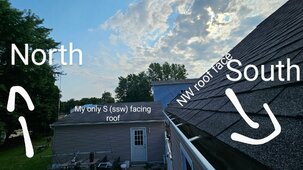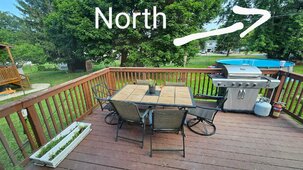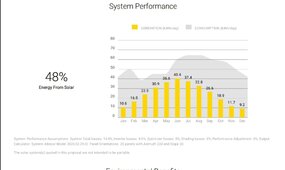Getting ready to install 8kw of panels, 20 in total. 16 will fit on my only south (ish) facing roof which is at roughly a 15 degree angle. I'm northern, on the south shore of lake erie.
The garage roof (pictured below) gets nearly 100% sun from about 10am to 8pm in the summer, and from about 11am to 5pm in the winter. That's where most of my panels are going.

Here's where it gets fun

This deck gets sun from about 630- till about 4pm in the summer, and from about 830am till about 2pm in the winter.
I was thinking about mounting some or all of my remaining panels on top of the railings to catch the early morning sun, laying flat, looking at the sky. I want to do vertical but i think it would look trashy. I'm not really convinced horizontal won't look trashy tbh.
Here is the lot I'm working with to give a better reference. Picture is roughly 4pm in late spring. Installing on the main house structure MAY be an option but only if it'll provide SIGNIFICANT benefit over somewhere else, it's a brand new roof and I don't enjoy poking holes.
The garage is unfinished, full tar papered under the mismatched shingles and uninsulated, I could give a crap less about that roof.

The front roof (south) looses sun when it goes behind the neighbor on the left's pine tree at about 5pm. In the winter, the large tree at the corner of my lot is almost a non factor once the leaves are gone.
Ideas, and discussion welcomed and needed. Thanks.
The garage roof (pictured below) gets nearly 100% sun from about 10am to 8pm in the summer, and from about 11am to 5pm in the winter. That's where most of my panels are going.

Here's where it gets fun

This deck gets sun from about 630- till about 4pm in the summer, and from about 830am till about 2pm in the winter.
I was thinking about mounting some or all of my remaining panels on top of the railings to catch the early morning sun, laying flat, looking at the sky. I want to do vertical but i think it would look trashy. I'm not really convinced horizontal won't look trashy tbh.
Here is the lot I'm working with to give a better reference. Picture is roughly 4pm in late spring. Installing on the main house structure MAY be an option but only if it'll provide SIGNIFICANT benefit over somewhere else, it's a brand new roof and I don't enjoy poking holes.
The garage is unfinished, full tar papered under the mismatched shingles and uninsulated, I could give a crap less about that roof.

The front roof (south) looses sun when it goes behind the neighbor on the left's pine tree at about 5pm. In the winter, the large tree at the corner of my lot is almost a non factor once the leaves are gone.
Ideas, and discussion welcomed and needed. Thanks.






